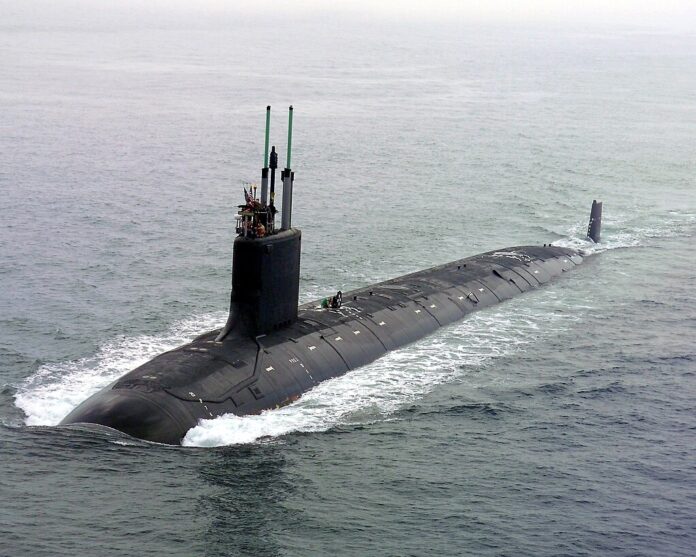USS Hawaii’s first overhaul abroad underscores the deepening collaboration between U.S. And Australian navies under the AUKUS pact
On August 22, 2024, the USS Hawaii (SSN-776), a Virginia-class fast-attack submarine, docked at HMAS Stirling, Australia’s western naval base, for a maintenance period. The visit, marked by gusty winds and a winter chill, represents a significant milestone in the evolving AUKUS defence partnership.
Lieutenant Will, a 26-year-old Royal Australian Navy (RAN) officer, piloted the submarine into port, reflecting on his unique journey from operating Collins-class submarines to navigating a U.S. nuclear-powered vessel. “It’s a career moment for me,” he said from the bridge, noting the excitement of returning to the harbour in a nuclear submarine after extensive training.
Embed from Getty ImagesThe USS Hawaii’s visit is the first instance of a U.S. nuclear-powered submarine undergoing overhaul on foreign soil. Accompanied by the submarine tender USS Emory S. Land (AS-39), this maintenance period highlights the growing integration of U.S. and Australian naval operations, a core element of the AUKUS partnership.
The AUKUS agreement, a trilateral security pact involving Australia, the United Kingdom, and the United States, aims to bolster Australia’s naval capabilities. This includes developing, building, and maintaining its own nuclear-powered submarine fleet with the U.S. sharing its nuclear propulsion technology for only the second time in history.
Rear Admiral Richard Seif, commander of the U.S. Navy’s Pacific submarine force, explained that the AUKUS pact has expanded cooperation beyond traditional exchanges of sonar and watch stations to full reactor operations. Australian sailors are now trained to operate nuclear reactors and manage all aspects of the submarine’s functionality.
Over the next few weeks, Australian sailors assigned to Emory S. Land will perform much of the maintenance on the Hawaii under the guidance of U.S. personnel. This includes routine tasks like mast swaps and handling nuclear materials, which are critical for maintaining the submarine’s operational readiness.
Vice Admiral Mark Hammond, chief of the RAN, highlighted the advanced nature of the Virginia-class submarines, noting that the integration of nuclear propulsion represents the “missing piece of the puzzle” for Australia’s submarine fleet. The collaboration reflects a deepening of the naval relationship between the U.S. and Australia, built on decades of mutual support and shared operations.
Training for Australian sailors has been extensive, with RAN personnel learning to operate and maintain nuclear reactors at U.S. submarine schools. Rear Admiral Matt Buckley of the RAN mentioned that about 100 Australian sailors will travel to the U.S. for further training in the coming months. This training includes both experienced officers and new recruits, signaling a comprehensive approach to building a skilled workforce for future Australian submarines.
The maintenance period also served as a platform for cross-training. RAN sailors who joined the crew of Emory S. Land gained valuable experience in maintaining Virginia-class and Los Angeles-class submarines. Notably, Able Seaman Marine Technician James Cooper and ABMT April Franklin earned U.S. enlisted surface warfare specialist pins, a testament to their proficiency and the high level of collaboration between the two navies.
Looking ahead, the U.S. plans to sell Virginia-class submarines to Australia in the 2030s, with options for up to five boats. Two of these will be Block IV submarines already in service, and one is expected to be a new Block VII boat. The AUKUS agreement outlines this future transfer as part of strengthening Australia’s naval capabilities.
Lieutenant Will’s ambition to command one of these submarines reflects the high stakes and personal goals tied to the AUKUS partnership. As he and USS Hawaii’s commanding officer, Cmdr. Daniel Jones, discussed during their port arrival, the collaboration aims to ensure a robust and integrated naval presence in the region.
Analysis:
Political Perspective: The docking of the USS Hawaii in Australia for repairs represents a tangible step forward in the AUKUS partnership, showcasing the strategic alignment between the U.S. and Australian navies. This cooperation not only enhances military capabilities but also signals a unified response to regional security challenges. The joint maintenance of a U.S. nuclear submarine on Australian soil highlights the political commitment of both nations to strengthening defense ties and mutual support under the AUKUS agreement.
Social Perspective: The maintenance period exemplifies the deepening of military relationships between the U.S. and Australia, reflecting broader trends of international cooperation in defence. For Australian sailors, the opportunity to work closely with U.S. counterparts and engage in advanced training represents a significant career milestone and fosters a shared sense of purpose. This collaboration enhances the cultural and professional exchange between the two navies, reinforcing the social bonds forged through military alliances.
Racial Perspective: While the immediate impact on racial dynamics is not overt, the integration of diverse naval personnel and the emphasis on inclusive training programs reflect broader values of diversity and international cooperation within military contexts. Ensuring equitable opportunities for all personnel, regardless of background, is crucial for maintaining morale and effectiveness in joint operations.
Gender Perspective: The involvement of female sailors such as ABMT April Franklin in the maintenance and training processes highlights the growing role of women in military operations and international defence partnerships. Their participation underscores the commitment to gender inclusivity within the naval forces and the importance of diverse perspectives in achieving operational excellence.
Economic Perspective: The repair and maintenance of the USS Hawaii in Australia are economically significant, underscoring the financial investment in maintaining and upgrading naval assets. The collaborative maintenance effort not only represents a cost-saving measure for both navies but also stimulates local economies through logistical and support activities. The future sale of Virginia-class submarines to Australia will further impact economic and defence spending, shaping the regional defence landscape for years to come.
